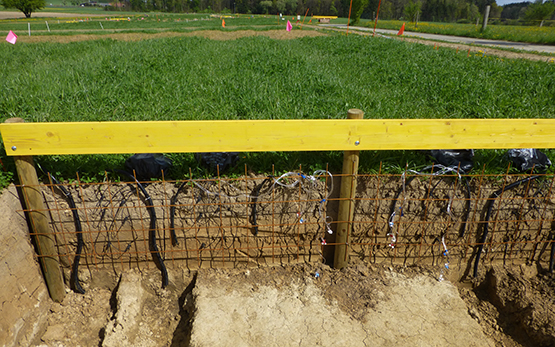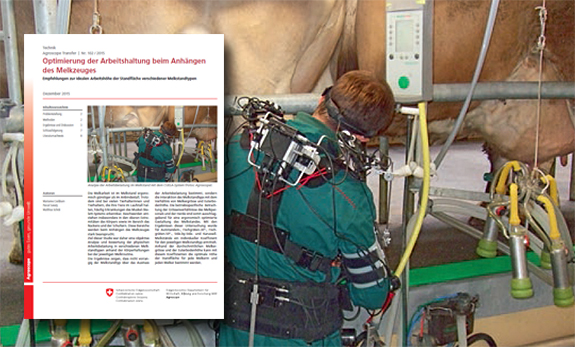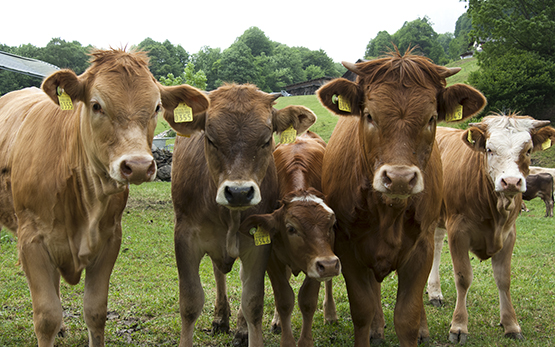Ruthes A. C., Dahlin P.
Des racines qui réveillent les vers.
Journal Agri, 25 avril, 2025, 18.
Ruthes A. C., Tiralongo E., Dahlin P.
Revisiting steroidal glycoalkaloids as hatching stimulants for Globodera rostochiensis and Globodera pallida.
Pest Management Science, In Press, 2025.
Viret O., Gindro K.
Science of fungi in grapevine.
Springer, Cham. 2025, 466 pp.
Spring J.-L., Gindro K., Schneider C.
Principaux programmes européens contemporains : Suisse: Station de recherche Agroscope.
In: Vignes tolérantes aux maladies fongiques: Des variétés à fruits pour une viticulture en transition agroécologique. Ed. Editions France Agricole, Saint-Ouen Cedex. 2024, 142-148.
Marcellin-Gros R., Hévin S., Chevalley C., Boccard J., Hofstetter V., Gindro K., Wolfender JL., Kehrli P.
An advanced metabolomic approach on grape skins untangles cultivar preferences by Drosophila suzukii for oviposition.
Frontiers in Plant Science, 15, 2024, Articolo 1435943.
Nitschke J., Huber R., Vossio S., Moreau D., Marcourt L., Gindro K., Queiroz E., Soldati T., Hanna N.
Discovery of anti-infective compounds against Mycobacterium marinum after biotransformation of simple natural stilbenes by a fungal secretome.
Frontiers in Microbiology, 15, 2024, Articolo 1439814.
Huber R., Marcourt L., Félix F., Tardy S., Michellod E., Scapozza L., Wolfender J.-L., Gindro K., Queiroz E.F.
Study of phenoxy radical couplings using the enzymatic secretome of Botrytis cinerea.
Frontiers in Chemistry, 12, 2024, 1-15.
Zuffa S., Schmid R., Bauermeister A., Gomes P. W. P., Caraballo-Rodriguez A. M., El Abiead Y., Aron A. T., Gentry E. C., Zemlin J., Gindro K., Massana Codina J., Dorrestein P.
microbeMASST: A taxonomically informed mass spectrometry search tool for microbial metabolomics data.
Nature Microbiology, 9, 2024, 336-345.
Alfattani A., Queiroz E. F., Marcourt L., Leoni S., Stien D., Hofstetter V., Gindro K., Perron K., Wolfender J.-L.
One-step bio-guided isolation of secondary metabolites from the endophytic fungus Penicillium crustosum using high-resolution semi-preparative HPLC.
Combinatorial Chemistry & High Throughput Screening, 27, (4), 2024, 573-583.
Buyck B., Hofstetter V., Horak E., Cooper J., Bougher N.
The search for Australian relatives of the eucalypt-associated Russula prolifica (Russulales) from Madagascar reveals new Oceanian taxa in subsection Auratinae.
Australian Journal of Taxonomy, 47, 2023, 1-25.
Pellissier L., Gaudry A., Vilette S., Lecoultre N., Rutz A., Allard P.-M., Marcourt L., Queiroz E. F., Chave J., Eparvier V., Stien D., Gindro K., Wolfender J.-L.
Comparative metabolomic study of fungal foliar endophytes and their long-lived host Astrocaryum sciophilum: A model for exploring the chemodiversity of host-microbe interactions.
Frontiers in Plant Science, 14, 2023, 1-22.
Grillon A. C., Gindro K., Chevalley C., Massana Codina J.
Antifungal evaluation of plant extracts as alternative fungicides for the management of early and late blight in potato crops.
In: European Association for Potato Research EAPR Pathology and Pests Section Meeting. 4 September, Arras. 2023, 1.
Schürch Gabus S., Gindro K., Schnée S., Dubuis P.-H., Massana Codina J., Wilhelm M., Riat A., Lamoth F., Sanglard D.
Occurrence of Aspergillus fumigatus azole resistance in soils from Switzerland.
Medical Mycology, 61, (11), 2023, 1-10.
Vigneron N., Grimplet J., Remolif E., Rienth M.
Unravelling molecular mechanisms involved in resistance priming against downy mildew (Plasmopara viticola) in grapevine (Vitis vinifera L.).
Scientific Reports, 13, 2023, 1-13.
Huber R., Marcourt L., Héritier M., Luscher A., Guebey L., Schnée S., Michellod E., Guerrier S., Wolfender J-L., Scapozza L., Köhler T., Gindro K., Queiroz E. F.
Generation of potent antibacterial compounds through enzymatic and chemical modifications of the trans-delta-viniferin scafold.
Scientific Reports, 13, (15986), 2023, 1-21.
Stucky T., Hochstrasser M., Meyer S., Segessemann T., Ruthes A. C., Ahrens C., Pelludat C., Dahlin P.
A novel robust screening assay identifies pseudomonas strains as reliable antagonists of the root-knot nematode Meloidogyne incognita.
Microorganisms, 11, (8), 2023, 1-16.
Zwygart A. C.-A., Medaglia C., Huber R., Poli R., Marcourt L., Schnée S., Michellod E., Mazel-Sanchez B., Constant S., Huang S., Bekliz M., Clément S., Gindro K., Ferreira Queiroz E., Tapparel C.
Antiviral properties of trans-δ-viniferin derivatives against enveloped viruses.
Biomedicine & Pharmacotherapy, 163, 2023, 1-11.
Oldani E., Cabianca A., Dahlin P., Ruthes A. C.
Biogas digestate as potential sorce for nematicides.
Environmental Technology & Innovation, 29, 2023, 1-14.
Rita de Souza C., Gindro K., Verdenal T., Spring J.-L., Spangenberg J.-E., Zufferey V.
Water deficit responses of field‑grown Pinot noir mediated by rootstock genotypes in a cool climate region.
OENO One, 56, (2), 2022, 136-148.
Zufferey V., Gindro K., Verdenal T., Murisier F., Viret O.
Anatomie et physiologie : Alimentation et carences, accidents physiologiques et climatiques.
AMTRA. La vigne (Vol. 4), 2022, 564 pp.
Monod V., Hofstetter V., Zufferey V., Viret O., Gindro K., Croll D.
Quantifying trade-offs in the choice of ribosomal barcoding markers for fungal amplicon sequencing: A case study on the grapevine trunk mycobiome.
Microbiology Spectrum, 10, (6), 2022, 1-13.
Gfeller A., Fuchsmann P., De Vrieze M., Gindro K., Weisskopf L.
Bacterial volatiles known to inhibit Phytophthora infestans are emitted on potato leaves by Pseudomonas strains.
Microorganisms, 10, (8), 2022, 1-11.
Dubey S., Pellaud S., Gindro K., Schuerch J., Golay J., Gloor R., Ghali K., Dubey O.
Fungal Infection in free-ranging snakes caused by opportunistic species.
Emerging Animal Species, 3, (May), 2022, 1-4.
Girelli C. R., Hussain M., Verweire D., Oehl M. C., Massana Codina J., Avendano M. S., Migoni D., Scortichini M., Fanizzi F. P.
Agro-active endo-therapy treated Xylella fastidiosa subsp. pauca-infected olive trees assessed by the first 1H-NMR-based metabolomic study.
Scientific Reports, 12, 2022, 1-13.
Huber R., Marcourt L., Quiros L., Luscher A., Schnée S., Michellod E., Ducret V., Kohler T., Perron K., Wolfender JL., Gindro K., Ferreira Queiroz E.
Chiral separation of stilbene dimers generated by biotransformation for absolute configuration determination and antibacterial evaluation.
Frontiers in Chemistry, 10, 2022, 1-11.
Gindro K., Schnée S., Lecoultre N., Michellod E., Zufferey V., Spring J.-L., Viret O., Dubuis P.-H.
Development of downy mildew in grape bunches of susceptible and resistant cultivars: Infection pathways and limited systemic spread.
Australian Journal of Grape and Wine Research, 28, (4), 2022, 572-580.
Huber R., Koval A., Marcourt L., Héritier M., Schnée S., Michellod E., Scapozza L., Katanaev V., Wolfender JL., Gindro K., Queiroz EF.
Chemoenzymatic Synthesis of Original Stilbene Dimers Possessing Wnt Inhibition Activity in Triple-Negative Breast Cancer Cells Using the Enzymatic Secretome of Botrytis cinerea Pers.
Frontiers in Chemistry, 10, (881298), 2022, 1-32.
Dessilly G., Pâques AT., Vandenbroucke AT., Hazée P., Gaume A., Gindro K., Schnée S., Lakaye F., Kabamba-Mukadi B.
In vitro evaluation of virucidal activity of disodium citrate perhydrate (2SCP) disinfectant against SARS-CoV-2 virus.
Journal of Global Antimicrobial Resistance, 28, 2022, 158-160.
Huber R., Marcourt L., Koval A., Schnée S., Righi D., Michellod E., Katanaev V., Wolfender JL., Gindro K., Queiroz E.
Chemoenzymatic synthesis of complex phenylpropanoid derivatives by the Botrytis cinerea secretome and evaluation of their Wnt inhibition activity.
Frontiers in Plant Science, 12, 2022, 1-19.









